Would you like to tag along with me on an actual Eamon adventure, to see how it really plays? Of course you would!
Eamon consists of a collection of BASIC programs spliced together with virtual duct tape and bailing wire. It’s an ingenious design given the limitations of a BASIC implementation running on an 8-bit computer, if also a bit horrifying to modern sensibilities of proper programming practice. Its structure is in fact strongly reminiscent of another early BASIC RPG we looked at not too long ago, Temple of Apshai.
All of the utilities on the Eamon master disk build a narrative frame around their rather prosaic functionality. When we boot up, the first scene that greets us is a hall of administration. (Yes, it seems that bureaucracy is alive and well even in the realms of fantasy.)
If we fail to go to the desk as instructed, the results are unfortunate. Here we see the first example of the disconcerting glee Donald Brown takes in killing off his players in the most arbitrary fashion. Just imagine what sort of tabletop dungeon master this guy would have made…
All of our current living characters are stored in a data file on the master list. If we follow instructions this time, we can choose one of them from the guild hall by simply entering a name.
If the name we enter is not in our current stable of adventurers, we get the opportunity to create a new character. A second BASIC program (“New Adventurer”) gets loaded in, and we’re off.
While Eamon‘s Dungeons and Dragons heritage is never less than obvious, its rules are not a slavish recreation of that system, if only because the technical realities of a 48 K computer make some serious simplification de rigueur. Case in point: the complexities of D&D characters are reduced to three randomly generated attribute scores, hardiness, agility, and charisma.
The system does not allow the player to have any role in the creation of her character beyond choosing a name and a sex. Three unlucky “die rolls” can leave her with an untenable character, and even a lucky roll or two in the wrong place can leave her with a character she’s just not interested in playing. Similar problems quickly led to new house rules — and, eventually, official rules — for character creation in D&D, attempting to mitigate the effects of luck and give the player more opportunity to exercise choice at this critical juncture that could define the player’s experience for days, weeks, or months of play to come. Similarly if more simply, one of the first common Eamon add-on programs was the morbidly named but useful “suicide” utility that let the player blow up a weak or otherwise unacceptable character and try again.
Whether we create a new character or play with an existing one, our character gets removed from the main characters file and placed in one that holds just the currently active character (“The Adventurer”). After the obligatory nerdy Star Trek reference, a third BASIC program starts up, “Main Hall.” It reads in “The Adventurer” (having each stage leave a data file lying around is the only practical way to get all of these programs to talk to one another), and we find ourselves in Eamon‘s main utility program, once again disguised as a fiction of its own.
Unlike Temple of Apshai, Eamon does have a rudimentary magic system consisting of four spells: blast, heal, speed, and power. The first three work as you might expect; the last is a rather ingenious cop-out, doing whatever the designer of a particular adventure decides it should do.
The “Main Hall” does have one unfortunate character, Shylock the banker.
I’m willing to give Brown a pass here, just because I don’t think he had a clue what sort of historical and cultural baggage his Shylock was toting behind him. And if one must crib antisemitism from someone, I can think of several worse people to draw from than Shakespeare. Anyway, let’s choose option 1 and go adventuring, shall we?
We’ll start, like aspiring Eamon players for time immemorial, with the adventure included on the master disk, Brown’s own “Beginners Cave.”
As you might expect, this is the most complicated part of Eamon. Just before “Main Hall” requests a scenario disk it deletes the player’s character from the master disk entirely. When the player inserts the scenario disk, her current character is written out to the optimistically titled “Fresh Meat” data file. The program then looks to another data file that should be present on the scenario disk, “Eamon.name,” for the name of yet another BASIC program to run; this constitutes the actual adventure. Brown and later Eamon maintainers provided a starting framework for this program, representing the first consciously designed reusable adventuring engine to be made available for general use. In its stock form, it lets the player navigate around a network of rooms (whose connections and contents are stored in “Eamon.rooms,” whose names are stored in “Eamon.room names,” and whose descriptions are stored in “Eamon.descriptions”); to fight monsters (whose attributes are defined in “Eamon.monsters”); and to pick up objects (described in “Eamon.artifacts”). The latter, in a zenlike simplification, can be worthwhile either as treasures (good for gold back at the main hall) or weapons (good for bashing monsters in scenarios as well as gold at the main hall). Brown provided utilities for populating these data files appropriately, but doing so could obviously yield only a very basic (no pun intended) adventure. To build more complicated interactions, to (to choose an example from Brown’s documentation) make a sword that teleports its owner to a random room at random times, the designer must modify the BASIC code of the starting framework itself. The result is infinite possibility of a sort, if a rather ugly way of achieving same; Brown imagined such scenarios as an Eamon adventure where “you are leading an army into battle, with morale affected by your charisma!”
But today we’re just going on a simple sort of Eamon adventure.
In my first post about Eamon, I called it a CRPG masquerading as a text adventure. That impression becomes all the more pronounced if we type something — and it’s not hard to do — that the simple two-word parser doesn’t understand. We get a list of all available commands in this adventure.
That’s something you’ll seldom see in a more traditional text adventure. It says something about Brown’s focus; he’s interested in the parser only as a means of getting commands into his program, judging it a better tool for that purpose than menus given the limited memory and screen real estate he has to work with. There’s a comparison to be made here to Robert Lafore’s “interactive fiction” games, which are really Choose-Your-Own Adventure-style choice-based narratives masquerading as text adventures. The focus of early Eamon is firmly on character building and monster bashing, not puzzle solving. Its resemblance to Adventure and the Scott Adams efforts is more an accident of history than a sign of similar intent. On the positive side, that means that guess-the-verb problems and other classic old-school parser frustrations are largely absent in Eamon. Perhaps, depending on your predilections, less positively, most attempts to depart from moving about and hitting things yield little result.
When “Beginners Cave” does try to get more ambitious, the results often leave you wishing it hadn’t. At one point you come upon a sinister, glowing book. If this happened in a tabletop D&D session, or even in a modern CRPG, you would have a variety of tools with which to investigate: perhaps a “detect magic” or “detect evil” spell, or a trip to the friendly local high-level mage. Here, though, we have only two options: just to recklessly read the thing or to leave it alone and wonder forever what it might be. If we read it, the worst quickly happens:
And so we have here yet another example of an early ludic narrative wanting to indulge in storytelling possibilities (similar mysterious artifacts being a staple of D&D adventures) that its underlying technology just cannot yet support, resulting in the worst kind of unfairness.
Similarly, “winning” in “Beginners Cave” requires us to discover a secret passage by typing EXAMINE in just the right location.
When we do so, we find a secret temple, and learn that our previously unstated goal was apparently to rescue “Duke Luxom’s not-too-bright daughter.” Ah, well, what would a quest be without a princess (or… what’s a duchess called before she becomes a duchess?) to rescue?
If we survive to return to the exit, our character is copied back over to the main disk, complete with whatever attribute improvements experience brought to him and whatever loot he picked up. If he doesn’t survive, he’s lost forever — remember, he got deleted from the master disk before we started the adventure.
I also recently played through a couple of other very early Eamon adventures: “The Zephyr Riverventure” (Adventure #4), by an employee at the Computer Emporium, Jim Jacobson; and “The Death Star” (Adventure #6), again by Brown himself. Both are much larger than “Beginners Cave,” but provide a similar mix of mapping, combat, and the occasional sudden death to keep everyone on their toes. “Riverventure” seems inspired by a movie of the time, Apocalypse Now.
“The Death Star” is based on the same middle act of Star Wars that inspired Dog Star Adventure, and is interesting as the first Eamon adventure to push the system into another milieu entirely.
I’m most interested, at least for now, in understanding Eamon‘s place in the early history of computerized ludic narrative; thus the attention I give here to these very early incarnations of the system. It’s only fair to note, however, that the sophistication of many later Eamon adventures was vastly greater than that of these early efforts. What I say here should by no means be taken as the last word on the system.
That said, there are certain problematic aspects that are endemic to the system, even if we leave aside its core focus on randomized combat that usually comes down to watching the roll of virtual dice and hoping for the best. In having players take their characters through a series of adventures, Brown clearly hoped to duplicate the feel of a classic D&D campaign, in which players play the same characters through a whole series of exploits, growing in power all the while, until retirement or death overtake them. In Eamon, though, death is too often capricious, coming at the whim of a designer. The dangers of combat are perhaps less problematic, but Eamon adventures were graded by difficulty in only the most cursory way, perhaps because, in the absence of defined character levels in Eamon, a consistent grading system was hard to devise. Small wonder that programs to “cheat,” to back up or resurrect characters, were soon included on the master disk itself. Such programs may ease considerable player pain, but they also of course to some extent pull against the core vision of Eamon itself.
I plan to finish this series off with the story of Eamon‘s post-Brown years very soon. If you would like to experience the system for yourself, the Eamon Adventurer’s Guild website is the best place to start. Here you’ll find disk images of all Eamon adventures that you can load using an Apple II emulator.
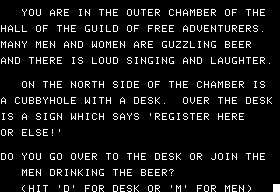
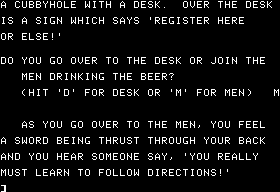
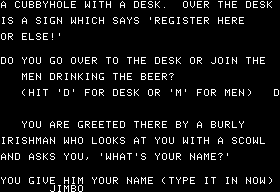
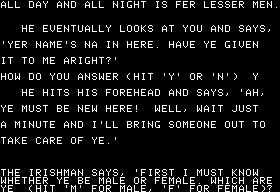
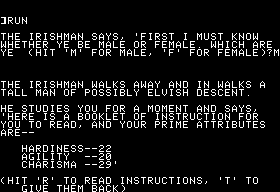
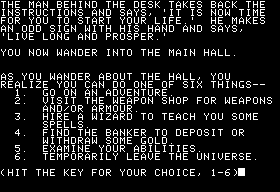
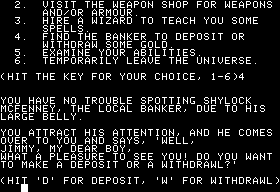
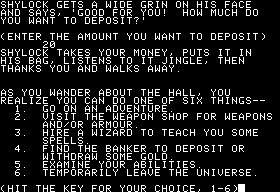
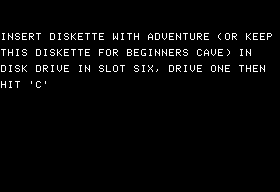
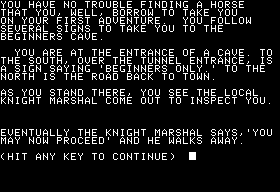
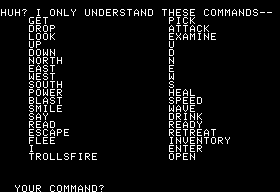
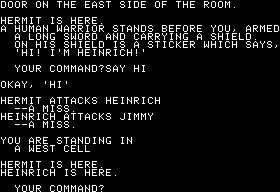
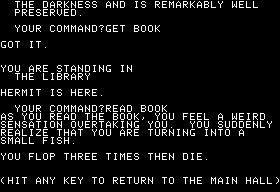
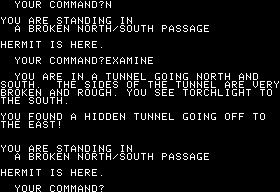
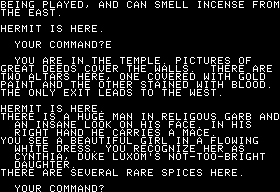
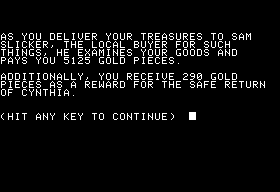
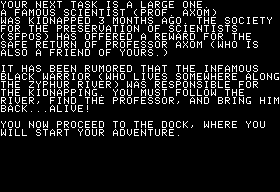
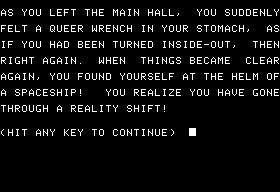
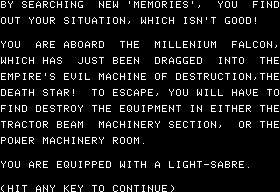










Nathan
September 24, 2011 at 8:40 pm
I have a hard time seeing anything antisemitic about a character named Shylock McFenney
Jimmy Maher
September 25, 2011 at 11:40 am
Well, maybe he just got his ethnic archetypes mixed up. :)
But just to be clear: I’m not seriously accusing Brown of anything here. I’m sure he was just a kid who had recently read The Merchant of Venice in class, and didn’t realize the difficulties that surround the Shylock character.
Jake
September 24, 2011 at 9:08 pm
in the absence of defined character levels in Eamon, a consistent grading system was hard to devise.
In fairness, character advancement was pretty hard to define in Eamon. Among your persistent characteristics were your stats, which only certain, rare adventures would mess with, your gold, which quickly became far more than you ever needed in the main hall, and your spells, which (as the gold comment above implies) you would presumably max out, since you could afford it. None of those three things really described any sort of “character advancement”, since after one or two quests (unless you make use of stat-enhancing quests), all of these properties would be as good as they were going to get.
So that leaves, as a metric of advancement, your weapon skills and equipment. Weapon skills advance inexorably over time with use, so that’s a pretty good measure of experience, but other elements of your kit are pretty hard to game — you can try to make sure you bring back good weapons from the quests, but while on the quests it’s not always clear which ones are good, and besides, they can break randomly.
matt w
September 24, 2011 at 11:59 pm
Cursory Google research — and isn’t that what we really need here? — suggests that she would be called “Lady Cynthia Luxom,” and that there isn’t there isn’t any particular word for a duchess’s daughter other than “lady.” That’s assuming we’re using the British system. On the French system all bets are off — somewhere in Proust someone shows their ill-breeding by assuming that the Prince de Guermantes outranks the Duc de Guermantes, and I was never able to understand why he didn’t.
Also, I think that first death isn’t arbitrary at all. They told you to register or else! What more of a clue do you want? A sign?
Victor Gijsbers
September 25, 2011 at 9:17 am
In German, the daughter of a baron is a “Baronin”, while the wife of a baron is a “Baronesse”.
In general, though, I don’t think the daughter of a baron has to have a title. It is not at all obvious that she will become a baroness later in life, for instance.
Dorte Lassen
October 9, 2011 at 6:41 pm
Well, I have to interfere just a little here. I don’t know much about computers, except what Jimmy taught me so far through our marriage. But I think that my German is still good enough to say:
“Baronesse” is the title of the daughter, and “Baronin” is the wife. :D
Another thing is that Germans are very, very pedantic about their titles. :P
Beardy
September 25, 2011 at 8:59 am
Adventure games in which the protagonist dies A LOT are fun! Well ….. to me anyway (trial & terminal error :P ).
I remember other applications that consisted of a set of programs that initiated eachother; YES its a somewhat sucky system BUT with limited memory its something that used to be unavoidable. Then again, for adventure games, switching data files should suffice for the most part surely?
Jimmy Maher
September 25, 2011 at 11:45 am
Yes, it’s ingenious and it works. I find it kind of cool to look at the structure of Eamon just because it’s so clearly the work of a talented kid without any formal computer-science education, and thus no understanding of how things “shouldn’t” be done holding him back from making the most of this really very primitive computer.
David Korabell
October 17, 2011 at 1:33 pm
I was very impressed when eamon first came out. The combat system derives from the RPG Runequest. One of the most unusual features was allowing for a ‘monster’ to become a ‘friend’ and fight along side of you if your charisma & it’s responsiveness werre amenable. There have been non-basic fan variants.
Sniffnoy
October 22, 2011 at 11:37 am
What on earth is the “Trollsfire” command?
Jimmy Maher
October 22, 2011 at 1:42 pm
The Trollsfire is a magic sword you can find. The “trollsfire” command just activates its special powers. It’s slipped my mind at the moment exactly what those powers were, though.
Nathan Segerlind
February 14, 2012 at 9:42 pm
The trollsfire sword would burst into green flame.
The command was valid only in the beginners cave.
Regarding the games that would twiddle with your gold and stats: This kind of normalization became necessary because it was possible for a player to bring insane firepower and stats in from another adventure, thereby making the current adventure a triviality. (It also led to genre bending like people bringing in ray gun weapons to a sword and sorcery setting.)
Eventually, Eamon authors started treating their titles as largely standalone with no interaction between separate titles, and the “player characters” became a vestigial customization with no intention of continuity or advancement.
Adele
January 17, 2018 at 8:31 pm
“even a lucky role or two in the wrong place”
Would that be a lucky roll or two?
Jimmy Maher
January 18, 2018 at 11:14 am
Indeed. Thanks!
Matt Ludwig
May 11, 2018 at 3:55 pm
This may have been intended as a pun, but I suspect “watching the roll of virtual device” was meant to be “dice.”
This is a super interesting subject and I’ve never heard of Eamon. I’ll have to check it out.
Will Moczarski
July 23, 2019 at 2:19 pm
the roll of virtual device -> should that be virtual dice?
Jimmy Maher
July 25, 2019 at 9:35 am
Thanks!